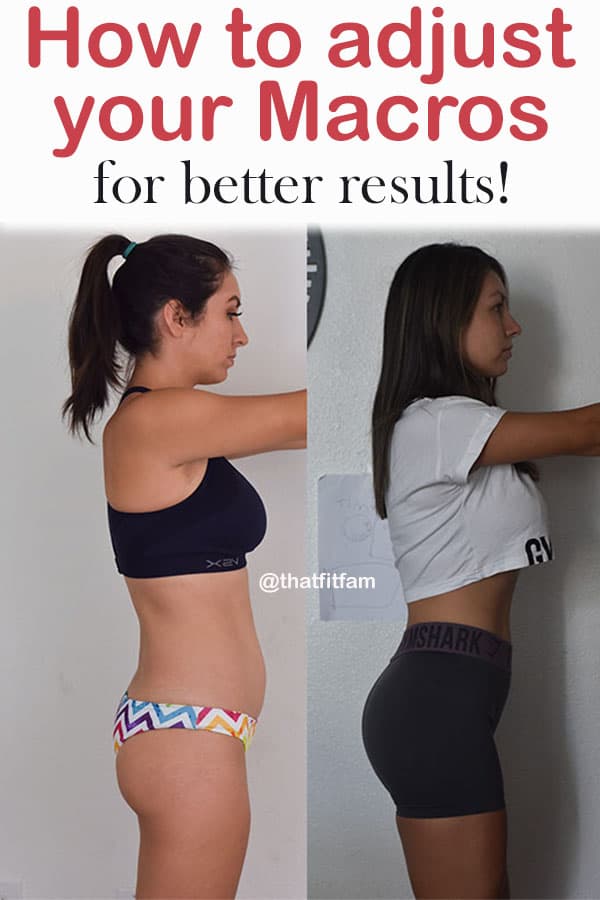Every IIFYM follower will at one point or another have to adjust their macros. Learning how to do this on your own is key to your success.

I’ve said before that we’ve been following IIFYM for over 4 years. It’s true. But, it doesn’t mean we’ve been in a deficit for 4 years.
A majority of that time I’ve actually been at maintenance and sometimes in a caloric surplus. I’ve also been at a deficit.
The amount of foods and the macro splits you use will vary based on your goals and you.
In my beginner’s post, I briefly went over a few macro splits that are based on percentages. That is a great starting point. But the truth is, there is no 1 size fits all percentage to use. That is why there is a huge range in those percentages recommended by bodybuilding.com
But that’s okay because I am going to explain how you can customize your macro split based on you and your goals.
Toward the bottom of this post, I will summarize the exact steps I would take while adjusting my macros but first I want to talk about the rules involved and why they are rules.

Rules for adjusting your macros:
1 gram of protein per pound of bodyweight.
This is the general rule. The exception to this is if you are obese. You would instead aim for 1 gram per pound of lean mass.
I would even argue, that either way (obese or not) it should be 1 gram per pound of lean body mass.
I would, personally, never consume more than 130 grams of protein. A professional body builder will probably advise otherwise, but a body builder physique isn’t everyone’s goal.
I currently weigh 128 pounds. When I am cutting (caloric deficit), I do my best to hit those high protein numbers because protein keeps you fuller.
Conversely, if I’m in a bulking or maintenance phase, I can keep my protein a tad lower (around 105 grams) because I have plenty of other calories to keep me full.
That means when I’m in a maintenance or bulking phase, I’ve lowered my protein to about .8 grams per pound. That is plenty of protein to maintain and build muscle. Compare that to the 1 g per pound which is recommended while cutting.

Why is it more during a cut?
First, like I mentioned previously it will keep your hunger at bay. And secondly, because protein requires more energy to digest than carbs & fats. So that basically means, you retain less of the calories coming from protein. Therefore, having a higher protein goal when you’re trying to lose fat is just smarter.
If your vegetarian or vegan:
Your protein goal will be lower and that’s fine.
The .8-1 gram per pound is a generally accepted rule in the U.S. but the bare minimum amount of protein needed is .8 per KG, which is closer to .36 grams protein per pound. So as you can see there is a pretty big range to work with and ultimately you need to do what works best for YOU.
From experience, I have found higher protein beneficial on a cut for the reasons mentioned above. I have also found it helps with my recovery after tough workouts. When I’m not cutting, I’m not so strict on my protein intake & set a lower goal.

30% calories from fat
This is another “rule” to follow when adjusting your macros. Basically 30% of your total calories should come from fat. You don’t want to dip lower than that or you risk messing with your hormones.
Because it is a percentage, the grams will vary as you increase or decrease your calorie intake.
The precise number is actually .4 g fat per pound of body weight, but I find that using a percentage gives me a few extra fat grams than using the .4 multiple.
The rest of your calories come from carbs.
Again, this will vary based on how many calories you consume. This is where you will see the most fluctuation when adjusting your macros.
On a cut, I may only consume 150 g carbs and on a bulk I may take in upwards of 220 g with my protein and fat intake hardly changing at all.
Fun Fact: Before, I mentioned protein requiring the most energy to digest. Carbs require the second most. And fats require the least. So, if you ever need a “diet break” it is best to overeat on protein and carbs instead of anything else. These buffalo chicken baked potatoes are perfect for that!

How to apply the rules:
When adjusting your macros, you should have a base set of numbers to go off of.
- Depending on your goals, either reduce or increase your calories by about 100 calories to start.
- Keep your protein the same.
- Make sure your fats are set to 30% of your new calorie goal. They should only change slightly.
- The rest of your calories will come from carbs.
- Wait 2 weeks before adjusting again (if needed).
The only reason you should ever need to adjust your macros is if your current numbers are no longer working for you which means you hit a plateau. This could either be because you changed goals or you changed body composition.



MyFitnessPal Hacks! - That Fit Fam
Thursday 18th of July 2019
[…] for you. These numbers are a good starting point, however, if you are familiar with IIFYM, you can adjust your macronutrients to what works best for you by switching up the percentages of each category. I always end up raising my protein and lowering […]